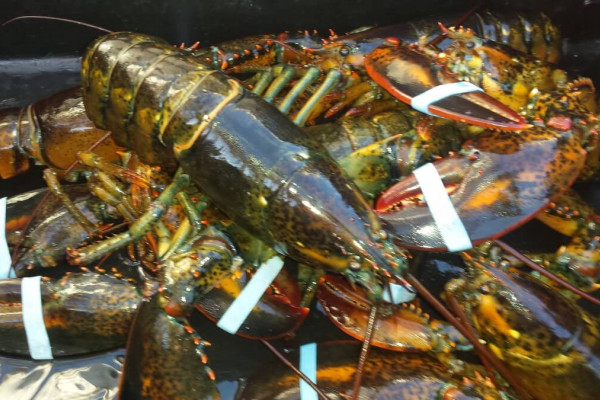
The Atlantic Large Whale Take Reduction Team agreed on gear modifications to help protect whales.
By Doreen Leggett
Seasonal gear bans to protect North Atlantic Right Whales in Cape Cod Bay and surrounding waters usually end May 1, but this year lobstermen in the Bay were off the water until May 10 because the highly endangered mammal was still seen in Cape Cod Bay.
More than a month later, June 16, several lobstermen were off the water again, but this time not by state edict. They were in district court in Boston to support a fellow lobsterman who was being sued, along with other groups and government agencies, by activist Richard “Max” Strahan.
The suit by Strahan, one of many in the last 20 years, would require a “green fishery” with no vertical buoy lines and, by the way, specifically permit him, a New Hampshire resident, to pursue that fishery in Massachusetts. It is yet another specter fishermen across the region are dealing with this season.
“It’s a waiting game,” said Captain Rob Martin. “Just trying to go to work and see what happens.”
The industry has been steadily changing habits and gear to protect the right whale since the 1990s and since 2014 have lived with an expanded three month seasonal closure implemented by National Oceanic and Atmospheric Administration Fisheries under rules that meet the requirements of the Marine Mammal Protection Act.
But on Sept. 18, 2017, some very bad news emerged.
A new assessment showed that from 1990 to 2010, the right whale population had increased, but beginning in 2010, a decrease by almost three percent a year was documented. That information was coupled with extremely high mortality and a perilously low birth rate in 2017, followed by no documented right whale births at all in 2018.
That news initiated another round of consultation under the Marine Mammal Protection Act and Endangered Species Act for nine fisheries, from lobster to dogfish to skate. Focus has been placed on fisheries because 85 percent of whales show evidence of entanglement, but managers are seldom able to identify where the gear came from.
“It’s on NOAA to make sure extinction doesn’t happen,” Mike Asaro, marine mammal branch chief of NOAA’s greater Atlantic region, said in an update to the New England Fishery Management Council.
The grim statistic is that 5.15 whales a year are being lost to entanglements, according to researchers, and the population can’t survive if even less than one whale a year is killed.
“It’s a very, very small margin of error,” said Asaro.
The Atlantic Large Whale Take Reduction Team has been meeting since 1996, but it’s on high alert now. The TRT, as it is called, is an advisory board set up under the Marine Mammal Protection Act to help develop plans to reduce risk to marine mammals posed by fishing gear. There are more than 60 members, pulled from industry, environmental groups, academia and government.
“We have had more meetings in the last year and a half than any other period,” said Colleen Coogan, a biologist who works with Asaro.
In the past, the situation was less dire because people thought the population was increasing, albeit slowly.
The issue is complicated by factors beyond fishermen’s control, such as ecosystem shifts that may be pushing whales into new areas, increasing stress and lowering births. More whales have been observed in the Gulf of Saint Lawrence, which led to a spate of entanglements, deaths, and a renewed commitment from Canadian officials to work with their U.S. counterparts.
But those more amorphous complications only put more pressure on the fisheries, the TRT brought forward nine proposals that included everything from more closed areas, to further gear modifications like ropeless buoys, to breakaway lines that should avoid entanglements. The goal? Reduce entanglement risk by 60 to 80 percent.
“This year was a tough meeting, people were expected to give and give a great deal,” said Lori Caron, who is married to long-time lobsterman Rob Martin (profiled in a companion piece) and is well-versed in the myriad lobster regulations.
Researchers from NOAA offered a model designed to work off three criteria: estimated number of right whales using an area, estimated number of vertical lines in an area, and risk assessment associated with each gear.
Before the meeting, there was a lot of focus on closing a large area southeast of here called 533, which many Cape captains depend on in winter and early spring to make a living.
Because the model showed closing the area would not provide enough benefits, 533 was not recommended for closures by the Take Reduction Team. Rather, the measures in the package approved after four days of meetings included reductions in vertical buoy lines as well as gear modifications to reduce the strength at which lines will break. Additionally, larger and more frequent gear markings on buoy lines were endorsed to help scientists and managers determine the source of gear on endangered large whales.
Maine has the most vertical lines in the water, and is holding meetings to identify ways to meet the framework reductions in the TRT’s recommendations. Massachusetts and Rhode Island are also expected to have meetings this summer. NOAA will then draft regulations, which will again go out for public comment this winter.
“The devil is in the details,” said Coogan. “We want to get input from the fishing industry and other stakeholders to develop those details.”
While those deliberations move forward, fishermen still have to be ready for the outcome of Max Strahan’s lawsuit and the issuance of a biological opinion under the Endangered Species Act, which is expected in January and could result in a jeopardy finding and far more draconian measures than what has been proposed.
Next year, according to managers, there will be continued focus on the lobster industry as well renewed attention on gillnet and Jonah crab fishermen.
“I hope we all stand together,” said Caron.
